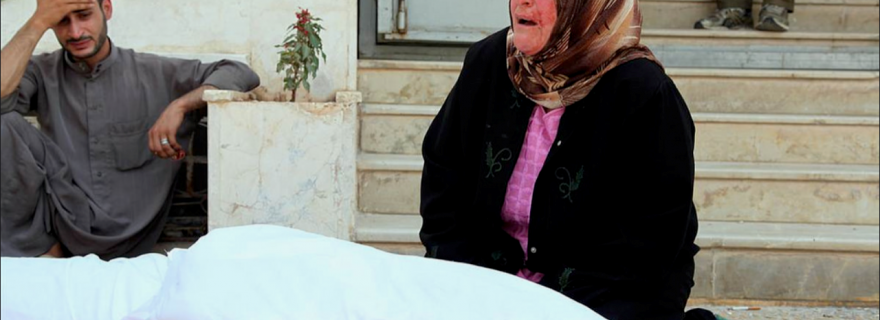Trauma and the Syrian Civil War: the Implications for Security
At least half of the Syrian refugees are believed to have developed severe mental issues as a result of the conflict, yet the stigma on trauma remains prevalent as ever.
This year’s Nobel Peace Prize was awarded to Nadia Murad, a Yazidi girl who was captured by Islamic State (IS) fighters in 2014 and held as a sex slave for several months. Her account The Last Girl: My Story of Captivity, and My Fight Against the Islamic State garnered worldwide acclaim for chronicling her horrendous journey through IS territory, forever at the whims of her captors, as a modern-day tragedy.
The war of our time
The Syrian civil war has been raging on since 2011 and though the intensity of the war has died down somewhat, there is still no sign of an imminent armistice. Meanwhile, an estimated 360.000 to 470.000 people (of which 110.000 are civilians) are thought to have lost their lives in this war and over 5 million Syrians have fled their homes.
Echoing Joseph Stalin’s statement that “the death of one man is a tragedy, the death of millions a statistic”, these numbers do not capture the grief and suffering that went hand in hand with the bombing raids on cities such as Aleppo, failed crossings of the Mediterranean Sea in ramshackle boats, or the barbaric chemical weapons attacks on civilians, including children. As a result, over 70 percent of Syrian children are thought to exhibit ‘toxic stress’ - with all of them reported experiencing an ‘overwhelming feeling of being unsafe’- and at least half of the Syrian refugees are believed to have developed severe mental issues as a result of the conflict.
The chain of the past
In his essay On the use and abuse of history for life, Friedrich Nietzsche claimed that what set human beings apart from animals is their capacity for historical reflection. They cannot avoid their past: ‘however far or fast he run, that chain runs with him’. By its very nature, though, this chain is too heavy to carry and thus we manage our past by conveniently ‘forgetting’ and remembering the events that shape our sense of self and identity; in short, our life.
For traumatized individuals, however, the matter is different. Their conduct of life at the mercy of their memory, their chains of the past weigh them down almost continuously, draining their energy, impeding their social interactions and engendering a pessimistic outlook on life. Trauma is a sudden, forceful blow to the psyche: an experience that transcends the human faculty for comprehending and making sense of the event. It can manifest in many ways; through hyperarousal, where the individual maintains a prolonged and often unwarranted state of heightened senses and vigilance; and intrusion, where the individual vividly relives the event.
Congruent with these physiological symptoms, the word ‘(psycho)trauma’ often evokes terms such as posttraumatic stress disorder (PTSD), depression and anxiety disorder. But while these are valid diagnostic constructs, they only capture generalized, categorical symptoms of people who have all experienced unique traumatic events and will process these in their own idiosyncratic ways. Exacerbating the issue of hyperarousal is a survivor’s sense of moral breakdown, as norms that previously facilitated social order and stability did not prove as resilient as was once thought, only adding to heightened feelings of insecurity. With their sense of self shattered and their worldviews uprooted, their way of relating to the outside world is forever changed, and many will never become more than a shadow of their former selves.
In addition, trauma is mediated in very social ways: in day-to-day social interactions and through cultural systems that regulate the manifestation of trauma through norms, values, taboos and roles. In Syria, where mental health care has been marginal at best (before the war there were 100 psychiatrists for 22 million people), the stigma on trauma remains prevalent as ever. People with mental health issues are commonly regarded as being possessed by demons. They are ‘majnun’, or crazy in Arabic.
The complexity of the Syrian civil war is also reflected in the breadth of personal traumatic experiences. Not everyone experienced sexual abuse or dug their own dead children out of the concrete rubble. People may wish to find solace in their communities but struggle to find commonalities with other people, as the incessant and unrelenting war compounds a series of mentally debilitating events into ‘complex trauma’. Moreover, in a country where all but a few have witnessed immense tragedy, it is likely that people do not wish to burden their peers with their sorrows, leaving their heartaches to fester as unattended wounds for many more years.
How then are societies to move forward in the aftermath of such mass transgressions of human integrity and dignity? People seek kinship in suffering, hoping to form some meaning-making narrative out of chaos, but their feelings of estrangement only contribute to the detriment of social cohesion and belonging. Previously peaceful and flourishing communities therefore become highly dysfunctional in the aftermath of war and conflict.
Moving forward, step by step
If there is one lesson Nadia Murad can teach us it is that in a country beset by tragedy suffering remains deeply personal. Addressing trauma should not merely involve adopting policies aimed at decreasing PTSD and depression rates. As trauma settles within the darker confines of the human psyche, it eventually embeds in the social structures, culture and identity, and so its highly contextual and unique nature must be recognized. It is only once we acknowledge the profound social ramifications of mass trauma that we can move towards a better understanding of the security situation in Syria, now and in the years to come.


